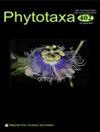Neottia linzhiensis (Orchidaceae, Epidendroideae, Neottieae), 中国西藏的一个新种
IF 1
4区 生物学
Q3 PLANT SCIENCES
引用次数: 0
摘要
报道了西藏墨脱兰科一新种林芝兰(Neottia linzhiensis)。林枝新木犀与短叶新木犀和台湾新木犀相似,但不同之处在于唇尖浅裂,柱状而非弯曲,柱头近在柱尖。本文章由计算机程序翻译,如有差异,请以英文原文为准。
Neottia linzhiensis (Orchidaceae, Epidendroideae, Neottieae), a new species from Xizang, China
A new species of Orchidaceae, Neottia linzhiensis, from Motuo, Xizang, China, is described and illustrated. Neottia linzhiensis is similar to N. brevicaulis and N. taizanensis, but differs from them by having lip shallowly bilobed at apex, column not curve, and stigma nearly at column apex.
求助全文
通过发布文献求助,成功后即可免费获取论文全文。
去求助
来源期刊

Phytotaxa
PLANT SCIENCES-
CiteScore
1.90
自引率
27.30%
发文量
956
审稿时长
1 months
期刊介绍:
Phytotaxa is a peer-reviewed, international journal for rapid publication of high quality papers on any aspect of systematic and taxonomic botany, with a preference for large taxonomic works such as monographs, floras, revisions and evolutionary studies and descriptions of new taxa. Phytotaxa covers all groups covered by the International Code of Nomenclature foralgae, fungi, and plants ICNafp (fungi, lichens, algae, diatoms, mosses, liverworts, hornworts, and vascular plants), both living and fossil. Phytotaxa was founded in 2009 as botanical sister journal to Zootaxa. It has a large editorial board, who are running this journal on a voluntary basis, and it is published by Magnolia Press (Auckland , New Zealand). It is also indexed by SCIE, JCR and Biosis.
All types of taxonomic, floristic and phytogeographic papers are considered, including theoretical papers and methodology, systematics and phylogeny, monographs, revisions and reviews, catalogues, biographies and bibliographies, history of botanical explorations, identification guides, floras, analyses of characters, phylogenetic studies and phytogeography, descriptions of taxa, typification and nomenclatural papers. Monographs and other long manuscripts (of 60 printed pages or more) can be published as books, which will receive an ISBN number as well as being part of the Phytotaxa series.
 求助内容:
求助内容: 应助结果提醒方式:
应助结果提醒方式:


